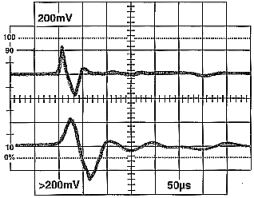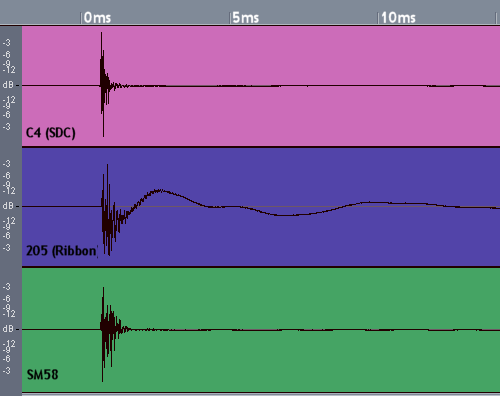 In audio, a transient is commonly defined as “an abrupt or sudden change in level.” We associate transients with sharp, harsh sounds: Think of cymbal crashes, hard-strummed acoustic guitar, and a singer’s T’s and CH’s.
In audio, a transient is commonly defined as “an abrupt or sudden change in level.” We associate transients with sharp, harsh sounds: Think of cymbal crashes, hard-strummed acoustic guitar, and a singer’s T’s and CH’s.
A microphone’s ability to accurately capture these transients is known as transient response, and it’s an important property to consider when selecting a mic. To understand why, think of how a microphone works.
Diaphragm and Transient Response
All studio mics operate on the same basic principle: Sound energy moves a diaphragm, and the diaphragm’s motion is converted to an electrical signal which can be measured and recorded.
Diaphragms differ from mic to mic. Dynamic mics have a coil or ribbon, where condenser mics have a lighter capacitor membrane. (For background, see Wikipedia’s page on microphones and the comprehensive microphones section on GSU’s Hyperphysics site.) Regardless of type, however, the motion of all diaphragms is governed by the laws of physics. Specifically, inertia: Lighter diaphragms require less energy to move than heavier diaphragms. Consequently, lighter diaphragms react quicker than heavier diaphragms to abrupt changes in sound energy. That is, they have a faster transient response.
Generally, we find the lightest diaphragms in small diaphragm condensers (SDC’s) while large diaphragm dynamic (LDD) mics have larger moving-coil diaphragms. As such, SDC mics are more responsive to transients than LDD mics.
 This diagram, taken from Shure’s indispensable Microphone Techniques for Music – Studio Recording, illustrates the response of a condenser mic and a dynamic mic to an electric spark impulse.
This diagram, taken from Shure’s indispensable Microphone Techniques for Music – Studio Recording, illustrates the response of a condenser mic and a dynamic mic to an electric spark impulse.
Though the difference is small, around 10 microseconds, the condenser mic (top line) responds more quickly to the impulse. Further, the dynamic diaphragm takes longer to stop moving after the impulse has passed. Note the continued “wobbling” on the right of the graph.
Diaphragm “stop” time
The difference in response is even more pronounced when viewed on a larger scale. To illustrate, I rigged an example with 3 microphones,
- Studio Projects C4 – an SDC
- Apex 205 – a cheap ribbon mic
- Shure SM58 – a small diaphragm dynamic mic
Here’s how the microphones respond to the click from a pair of drum sticks:

The differences are striking. The C4 (on top) has what I’d characterize as the “cleanest” response. The SM58 (on bottom) took about twice as long to “settle down” after the sound had passed.
And the ribbon mic (in the middle) has a completely different extended response. You can practically see the ribbon itself flapping back and forth inside the mic, taking almost 10 milliseconds to settle.
Choosing the right transient response
It’s important to note that just because a microphone has a faster transient response, it’s not necessarily a better mic. As always in recording and mixing, your ears are the final judge of “better,” and sometimes you’ll simply prefer the sound of a sluggish diaphragm. Many people, for example, opt to use ribbon mics as drum overheads precisely because the ribbon’s response softens harsh-sounding cymbals.
There are a few general guidelines, however, when considering how a microphone’s transient response will affect your recordings:
Compression: Larger diaphragms, with their slow response, tend to naturally compress a sound, smoothing out the transients
Smearing: Additionally, since large diaphragms take longer to stop moving after a sound has passed, they can also smear transients, sometimes blending one into the next.
These effects combine, in varying degrees depending on the mic, to yield a dark or flattened sound, generally suitable for bass, electric guitar, and edgy vocals.
Detail: Condenser mics, especially SDCs, better represent the transients we hear and, as such, yield a more detailed sound.
Higher frequencies: High frequency sounds tend to produce sharper transients, in which smaller diaphragm mics are better at capturing nuance.
These effects combine to yield a brighter, crisper sound, generally appropriate for acoustic guitar, drum cymbals, and delicate singers.
I’ve seen this all summarized as:
Faster – brighter, slower – darker.
Of course, that’s a very general guideline, because there are other important properties of a mic to consider (e.g. polar pattern, frequency response.) But when choosing a mic, it always helps to remember how its responsiveness will colour the sound of the instrument you’re recording.
Tags: microphones, miking

3 comments
Trackback URI Comments feed for this article
I suspect that the transient response you’re seeing on that ribbon is caused more by the particular choice of ribbon. Chinese ribbon mics like the 205 have a very high rate of insufficient ribbon tension (like two out of every three of them). The result is that the ribbon slaps around wildly. Retension your ribbon and I suspect that long tail will almost completely go away, putting it somewhere between the SDC and the dynamic.
David,
I’m not sure the “flapping” is tension related (or even related to the ribbon at all.) The ribbon mic in the samples above was this one, before I modded it: http://www.hometracked.com/2007/08/17/ribbon-mic-mod-part-1-apex-205/
You can see in a few of the pics that the tension’s right where it should be.
I wonder now, after the fact, if I’m just seeing resonance in the canister. Probably I should record another sample with the modded mic.
how come the middle sample is below the line so much ? I saw a recording where it was all under the line and I wanted to try and make that because it sounded real crunchy